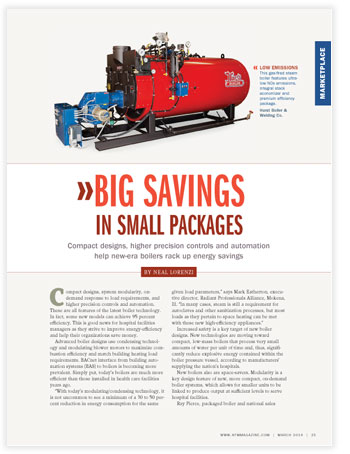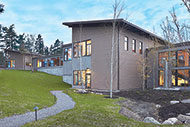 Compact designs, system modularity, on-demand response to load requirements, and higher precision controls and automation. These are all features of the latest boiler technology. In fact, some new models can achieve 95 percent efficiency. This is good news for hospital facilities managers as they strive to improve energy-efficiency and help their organizations save money.
Compact designs, system modularity, on-demand response to load requirements, and higher precision controls and automation. These are all features of the latest boiler technology. In fact, some new models can achieve 95 percent efficiency. This is good news for hospital facilities managers as they strive to improve energy-efficiency and help their organizations save money.
Advanced boiler designs use condensing technology and modulating blower motors to maximize combustion efficiency and match building heating load requirements. BACnet interface from building automation systems (BAS) to boilers is becoming more prevalent. Simply put, today's boilers are much more efficient than those installed in health care facilities years ago.
"With today's modulating/condensing technology, it is not uncommon to see a minimum of a 30 to 50 percent reduction in energy consumption for the same given load parameters," says Mark Eatherton, executive director, Radiant Professionals Alliance, Mokena, Ill. "In many cases, steam is still a requirement for autoclaves and other sanitization processes, but most loads as they pertain to space heating can be met with these new high-efficiency appliances."
Increased safety is a key target of new boiler designs. New technologies are moving toward compact, low-mass boilers that process very small amounts of water per unit of time and, thus, significantly reduce explosive energy contained within the boiler pressure vessel, according to manufacturers' supplying the nation's hospitals.
New boilers also are space-savers. Modularity is a key design feature of new, more compact, on-demand boiler systems, which allows for smaller units to be linked to produce output at sufficient levels to serve hospital facilities.
Ray Pierce, packaged boiler and national sales manager, Hurst Boiler & Welding Co., Coolidge, Ga., says his company strives to offer space-saving boilers for hospital applications. "On the other hand, we maintain that smaller is not necessarily better. Low-mass steam boilers — boilers with little steam storage capacity — can be problematic. Our goal is to provide boilers to hospitals that will operate satisfactorily for the next 30 years."
New boilers are designed for emergency management — to run during natural and man-made disasters. "Many new boilers run on two types of fuel such as natural gas piped in from a utility company and from a locally stored source such as propane," says Chuck O'Donnell, director of marketing for Laars Heating Systems Co., Rochester, N.H. "As long as there is a backup generator supplying electricity, a boiler can be switched over to the locally stored source of fuel to supply heat during such an emergency."
One interesting trend in reliability/emergency management/storm-proofing boiler systems is utilizing the compact size of on-demand units to position the entire system above ground on a mezzanine within the energy plant to protect it from flooding and other disasters, experts say.
Maintenance challenges
Hospitals pose challenges to boiler manufacturers as budgets are curtailed in the health care area, which limits what maintenance departments can do for the physical plant. Hospital boilers often are sized larger than needed, says Pierce. "We often find that hospitals have two boilers, one of which is redundant and for backup. For the greatest efficiency, these boiler rooms would be better served using three or four smaller boilers, which can be brought online as needed."
Facilities managers sometimes look only at boiler fuel costs, Pierce adds. "We need to be looking at total efficiency, and the electrical motor load is a primary area. Therefore, Hurst strives to manufacture boilers that require smaller electric motors for combustion air, and smaller motors for pumps. We promote variable-speed drives in every case," he notes.
It isn't just the boiler that determines energy savings but the boiler installation, experts agree. While boilers themselves have well-established, high-efficiency performance levels, improvements in applications to minimize cold-water return temperatures and maximize operational efficiency continue to gain attention. High-efficiency radiation is becoming available, which helps in this area.
There are two schools of thought when it comes to the centralization of boilers, says Ray Wohlfarth, president of Fire & Ice Heating & Cooling, Pittsburgh, and author of the book, Lessons Learned in a Boiler Room. While some opt to simply put bandages on older boilers, others are looking at pulling loads away from the central boiler. "Engineers are asking if they could heat some sources differently. For instance, some think that domestic hot water can be heated for less by using smaller, more efficient water heaters."
Innovative introductions
Jim Fino, marketing manager, Harsco Industrial Patterson-Kelley, East Stroudsburg, Pa., says that higher boiler efficiency has a significant impact on the total cost of ownership. The company's P-K SONIC boiler, featuring DUET Technology, contains a stainless steel heat exchanger design, which reportedly allows the unit to operate at more than 95 percent efficiency with ultra-low emissions. In addition, the boiler is designed with a small footprint requiring less mechanical room space, thus reducing the expense required to move it into the desired position.
The new MagnaTherm from Laars Heating Systems Co. is a 95 percent thermal efficiency, modulating-condensing boiler available in 2-, 3- and 4-million Btu/h sizes. It features a 5:1 turndown, small footprint, stainless steel heat exchanger and multiple voltage options to match building service. Its pump control matches boiler firing rate to boiler pump flow, reportedly reducing boiler pumping costs by as much as 70 percent. A touchscreen display offers quick setup and diagnostics.
"Advanced boiler designs use condensing technology, modulating blower motors and variable-speed pumping to maximize combustion efficiency and match building heating load requirements," says O'Donnell. "However, the condensate is corrosive to materials such as copper, aluminum and cast iron, so stainless steel heat exchangers should be used when condensing occurs."
Bradford White Corp., Ambler, Pa., has introduced the Brute Elite Series of gas-fired, modulating-condensing boilers. The boilers are rated at 95 percent annual fuel-utilization efficiency and modulate down to 20 percent of full fire (5:1 turndown). The systems can be horizontally or vertically direct-vented with vent and air pipe lengths of up to 100 equivalent feet. The boilers also feature direct spark ignition, vent temperature cutoff, a stainless steel heat chamber with no gaskets and electronic proportional-integral-derivative (PID) modulating control. The boilers communicate with BAS via Modbus ports.
Taco Inc., Cranston, R.I., has introduced boiler-staging controls that make it possible for individual boilers to operate at peak efficiency. To do this, the controller monitors sequential or parallel firing for each individual boiler in the system.
"The controller receives feedback from networked devices, such as air-handling units or variable-air volume systems, to determine conditions in the zones and actual need for additional hot water. This is combined with current and future outdoor conditions to allow the boiler control to optimize all loop temperatures when there are demands for heat," says Ric Turmel, LEED AP, iWorx division manager, Taco Inc.
Ajax Boiler Inc., Santa Ana, Calif., has introduced the Triton-Atlas Series of boilers featuring 86 percent thermal efficiency. The boilers incorporate Honeywell's SOLA controls, which provide the user with full control of boiler settings from a single interface. By integrating numerous functions into a compact device, SOLA reportedly offers an increased range of programming functionality while reducing the need for wiring and cutting installation time. Programmable features include flame safeguard, pump control, central heating/domestic hot water high limits and PID load control.
Sustainable service
Miura North America Inc., Irwindale, Calif., a global manufacturer of integrated boiler systems, has focused recent innovations on reducing harmful emissions, improving water quality management for boiler feed-water systems and maximizing heat recovery potential from its integrated feed-water economizer.
"Miura's approach to emissions reduction dismisses conventional approaches that focus on post-combustion mitigation by reducing the amount of emissions generated during combustion in the first place through net fuel reduction/output and innovative burner design," says Jason Smith, LEED AP, general manager, sustainability and strategic development.
"The burner for the LX series boiler is a large-surface area, pre-mix burner that directly impinges on the water tubes," he explains. "This design eliminates the hot spots associated with nozzle-type burners. This, in effect, lowers the overall flame temperature, minimizing thermal nitrogen oxide (NOx) production, which is directly proportional to combustion temperature."
Boilers have a direct impact on hospital sustainability initiatives because of the significant consumption of fuel, water and electricity related to their operation. Boilers, which operate via the combustion process, also are a source of site-generated carbon dioxide emissions. Thus, emissions reduction is a primary goal of boiler manufacturers.
California seems to be the focus of the latest boiler emissions standards. "One of the main exhaust standards that affects boilers is South Coast Air Quality Management District (SCAQMD) Rule 1146.2 in California," says Chad Sanborn, product marketing manager, Bradford White Corp. "This standard limits NOx emissions to less than 20 parts per million. These SCAQMD standards are setting the stage for other regions of the country to require low-NOx-certified equipment."
Mandatory emissions regulations, such as those governing NOx, have shown a significant percentage of reductions in thresholds during recent compliance cycles, adds Smith. "Expect to see NOx as a more significant driver in boiler upgrades and selection with sharp trends down in NOx emissions thresholds required by states that intend to meet the Environmental Protection Agency's ozone limit."
Neal Lorenzi is a freelance writer specializing in health care and is based in Mundelein, Ill.
FOR MORE INFORMATION
For further information about the systems featured in this month's Marketplace report, contact the following vendors:
» Ajax Boiler Inc.
www.ajaxboiler.com
» Bradford White Corp.
www.bradfordwhite.com
» Harsco Industrial Patterson-Kelley
www.harscopk.com
» Hurst Boiler & Welding Co.
www.hurstboiler.com
» Laars Heating Systems Co.
www.laars.com
» Miura North America Inc.
www.miuraboiler.com
» Taco Inc.
www.taco-hvac.com





